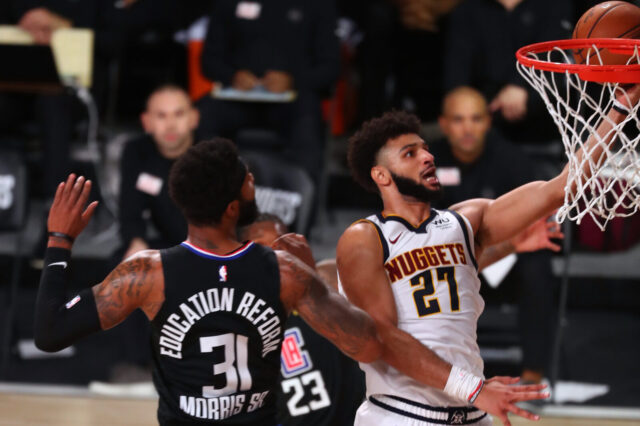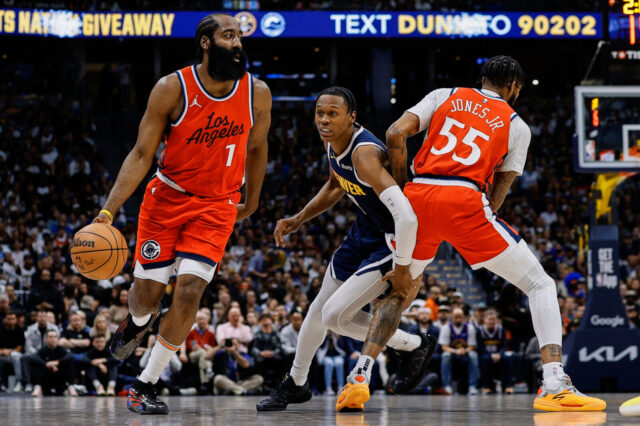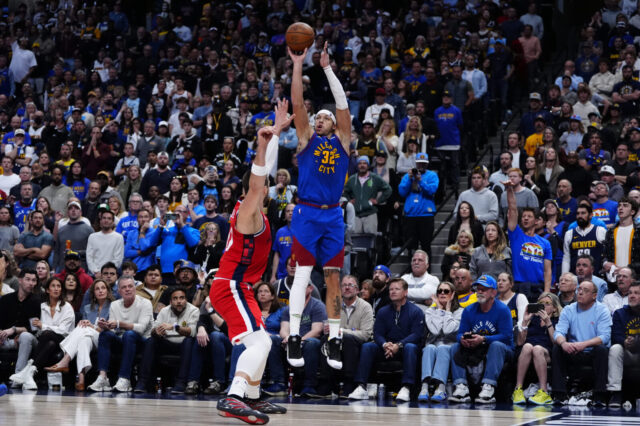Overview
Nikola Jokic had a somewhat up and down season, relative to the standard he set for himself in the 2016-17 season. Overall he improved in every counting stat including minutes, points, rebounds, and assists per game and strung together the best 10-week stretch of his career, beginning in late January and continuing on through the end of the season. He won two player of the week awards and will receive at least some all-nba votes. He tallied 10 triple-doubles, becoming the all-time leader in triple-doubles by a foreign-born player and recording the most triple-doubles by a center since 1977.
But Jokic’s season was up and down because he played fairly differently over the first half of the season compared to the last, both in terms of style and in terms of impact. In the first half of the season, Jokic blended into the roster more than he stood out. His points, rebounds, and assists were all much lower in the 2017 potion of the season than they were in 2018 despite the fact that he went through a rare shooting slump in the first few weeks of January.
This content is no longer available.
This content is no longer available.
Much of the change in his performance between the front half and back half of the season was heavily influenced by the team’s style of play and the lineup combinations Jokic was thrown into. Unlike in 2016-17, the Nuggets ran a much more scripted offense in the first half of the season with play calls coming from the sideline rather than the free-flowing, read and react identity that they had cultivated the year before. The team also played with two traditional bigs much more frequently than last season, with either Mason Plumlee or Paul Millsap alongside Jokic in the front court.
Those stylistic and lineup changes seemed to affect the Nuggets collectively but was especially influential on Jokic who saw his shot profile change quite dramatically from his sophomore season. Jokic attempted much fewer shots at the rim this season compared to last season and took much more of his shots from the mid-range and behind the three-point arc. His assists per game rose from last year but there were slightly fewer highlights.
Nonetheless, Jokic grew as a player over the course of the season and solidified himself as the team’s best and most important player. His final month of the season was a tour de force, highlighting the many facets of his game and his ability to take over in big moments. His defense continues to be a work in progress – especially in the pick-and-roll – but for the third straight season, the Nuggets were better defensively with him on the court. Overall, it was a successful year for the Joker, a year that ended with the young center playing the best basketball of his career.
Key Stat
39.6% – Over his first two seasons, Jokic made just 73 of his 223 three-point field goal attempts, good for 32.7%. This season, Jokic took 280 three-point shots and made 111 of them, good for 39.6%. Only Karl-Anthony Towns matched that number of attempts with that efficiency from the center position and only Dirk Nowitzki had a similar output from the power forward position this season. Jokic was already one of the most complete offensive weapons in basketball but if his 40% three-point shooting is here to stay he’ll become even more unstoppable and open up even more opportunities for drives, cuts, and post-ups.
Best moment
Jokic seemed to have fewer moments than last season, possibly due to a change in style of play alongside Plumlee and Millsap. Or perhaps we’ve just become more accustomed to the no-look passes and soft shooting touch? But even if there were fewer moments, there was still brilliant stretches of basketball sprinkled throughout the season. Joker nearly averaged a triple-double for the entire month of February. He played like the best player in the NBA over the final two weeks of the season, a span that saw the Nuggets finish on a six-game winning streak before falling in overtime to the Minnesota Timberwolves in the season’s final game.
But if there was one game that stands out it was the record-setting triple-double performance against the Milwaukee Bucks. He tallied the triple-double in just 14 minutes and 33 seconds, the fastest mark in NBA history. He finished the game with 30 points, 15 rebounds, and an incredible 17 assists to lead the Nuggets to a much-needed road win.
Areas of strength
Just about everything on offense – At this point, there really aren’t many weaknesses to Jokic’s game on the offensive end. He’s one of the best playmakers out of post-ups, pick-and-rolls (PnR), and dribble handoffs. He’s one of the best scorers on post-ups, spot ups, and rolls to the rim. His shot selection and decision making aren’t comparable to any other big in the game. His touch remains incredible from every spot on the floor and he might already be the best passing center in NBA history. Most important of all, he makes every single Nuggets player better offensively just by being on the floor.
This content is no longer available.
Area to improve
The obvious answer is defensively, especially in the PnR. However, for purposes of this column, I’ll highlight the one improvement he can make offensively that will open up his game even more and make him a more reliable end-of-game closer: using his left hand (and right shoulder) in the post.
Jokic generated 1.03 points per possession off of post-ups, a very good mark for a player who posts as frequently as he does. He has elite vision from the post and excellent feel for how to draw the double team and when and where to deliver the pass once the second defender arrives. Few teams have defenders who can guard him on the left block but those that do seem to understand that he is much more dangerous going over his left shoulder than his right. Smart defenders like Minnesota’s Taj Gibson sit on his left shoulder, strongly encouraging him to finish over his right shoulder with his left hand.
While Jokic is very good at not letting the defense dictate what direction he goes in the post, it’s much easier to keep the defense off balance over the first 44 minutes of the game than it is in the final 4. In the final minutes, defenses lock into teams to try to force as much one-on-one action as they can. For Jokic, this means teams guarding him one-on-one and forcing him to his left.
Jokic has two tendencies when he goes to his right shoulder: he either turns into a fallaway jump shot or he turns over his right shoulder but finishes with his right hand. The fallaway is usually a win for the defense. Jokic has great touch on his fallaway but it is still a less efficient shot than his jump hook or spin move. The right handed finish is also feast or famine. It catches some defenders off-guard but better defenders anticipate the shot and are able to contest it.
Expectations for next year
I got to talk to Jokic one-on-one at media day last year and my first question was about coming into the season as Denver’s best player. He laughed off that question saying that Paul Millsap was a four-time all-star and that the team was built around him. Indeed, that appeared to be the case early in the year as Jokic took a back seat to Millsap. In the second game of the season, Jokic went scoreless on just thee shot attempts.
Then, after Millsap’s wrist injury took him out of the lineup, Mason Plumlee joined Jokic in the starting lineup, sliding Jokic over to power forward. Over the next two months, Jokic looked slightly less effective than we became accustomed to last season. Meanwhile, Gary Harris stepped into the spotlight, prompting many Nuggets fans and analysts to wonder if Harris is actually the team’s best player.
When Plumlee got injured in late January, the Nuggets were forced to play smaller lineups where the ball flowed though Jokic. The team immediately rallied off their best month of the season and Jokic regained his role as the team’s focal point. However, the transformation wasn’t complete. Once Millsap returned to the lineup at the end of February, there was still the lingering question of who’s team this really was. After a few uncomfortable games and a handful of excruciating losses to bad teams, Millsap sat down with Jokic and shared what everyone watching at home could see: this was Jokic’s team and he needed to be the guy.
From that point on, Jokic attacked each game like a player who knew where he stood at the top of the pecking order. Over the final 18 games of the season, Jokic averaged 24 points, 11.5 rebounds, 6.4 assists, 1.4 steals, and 1 block per game while shooting 54% from the field and 47.6% from behind the arc. In a sample size of nearly 1⁄4 of the season, Jokic averaged a statline that has only been achieved over a full season by two players in NBA history: Wilt Chamberlain and Oscar Robertson. Equally as important, the team looked toward him to be the guy. And he delivered. Entering next season, Jokic should know what his role is on this team and what it means to accept that role.
Lastly, I am reminded of the answer that Kevin Durant gave me earlier in the year when I asked him what he thought of Denver’s young, Serbian phenom.
Durant’s response seemed uniquely candid, not just in his assessment of Jokic’s game but also in what it is going to take for Jokic to take the step from talented young player to superstar. I remember walking away from that interview feeling like Durant was sort of speaking to Jokic through the media, offering him some important advice about what it takes to be a star in this league.
“Man he’s different, he’s different. He’s still young, though. That’s the thing. You gotta let him develop and grow. But his feel for the game for a young player like that, the way he pushes the break, shoot the three, shoot the mid-range…now it’s just a matter of consistently, every single day just knowing work habits and knowing how hard it is to lead your team to a W. That’s something that every young player goes though in this league especially as talented as him. He’s going to figure it out at some point and he’s going to be a force for a long time.”
To me, that’s what this season represented. Jokic had to go through something that all young players have to go through. He had to learn lessons that only come through experience, failure, success, ups, and downs. It seems as though Jokic got a taste of what it takes to lead a team, not just as the most talented player, but as the pillar. The mental and physical burden a player must place on themselves in order to become truly great. The final six weeks of the season felt like a great player stepping up and accepting that role and all of the responsibilities that comes with it.
As Jokic is set to get sign a lucrative extension this summer, one that will make him wealthy beyond his wildest imaginations, he looks like he is ready to turn a very important corner. The talent was always there. But next season, Jokic will need to be prepared to approach every minute of every game like the star this team needs him to be and knows that he can be. Next year, when asked if this Nuggets teams is his team, I expect that there will be a knowing nod of acceptance, even if he is too humble to say so himself.


